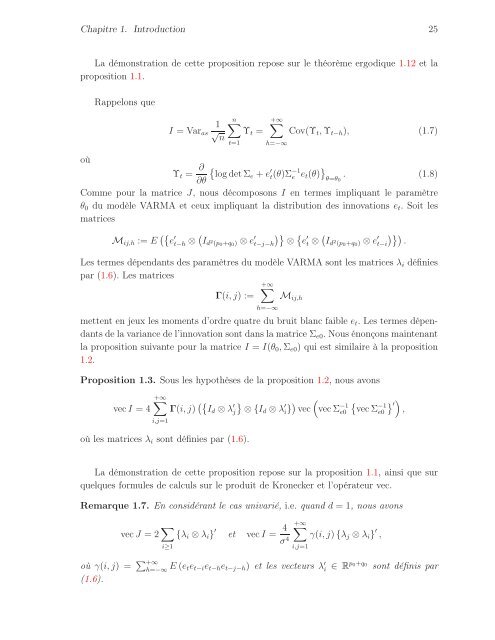THÈSE Estimation, validation et identification des modèles ARMA ...
THÈSE Estimation, validation et identification des modèles ARMA ...
THÈSE Estimation, validation et identification des modèles ARMA ...
You also want an ePaper? Increase the reach of your titles
YUMPU automatically turns print PDFs into web optimized ePapers that Google loves.
Chapitre 1. Introduction 25<br />
La démonstration de c<strong>et</strong>te proposition repose sur le théorème ergodique 1.12 <strong>et</strong> la<br />
proposition 1.1.<br />
Rappelons que<br />
I = Varas<br />
1<br />
√ n<br />
n<br />
t=1<br />
Υt =<br />
+∞<br />
h=−∞<br />
Cov(Υt,Υt−h), (1.7)<br />
où<br />
Υt = ∂ <br />
logd<strong>et</strong>Σe +e<br />
∂θ<br />
′ t(θ)Σ −1<br />
e <strong>et</strong>(θ) <br />
. (1.8)<br />
θ=θ0<br />
Comme pour la matrice J, nous décomposons I en termes impliquant le paramètre<br />
θ0 du modèle V<strong>ARMA</strong> <strong>et</strong> ceux impliquant la distribution <strong>des</strong> innovations <strong>et</strong>. Soit les<br />
matrices<br />
Mij,h := E e ′ t−h ⊗ Id 2 (p0+q0) ⊗e ′ t−j−h<br />
′<br />
⊗ e t ⊗ Id2 (p0+q0) ⊗e ′ <br />
t−i .<br />
Les termes dépendants <strong>des</strong> paramètres du modèle V<strong>ARMA</strong> sont les matrices λi définies<br />
par (1.6). Les matrices<br />
Γ(i,j) :=<br />
+∞<br />
h=−∞<br />
Mij,h<br />
m<strong>et</strong>tent en jeux les moments d’ordre quatre du bruit blanc faible <strong>et</strong>. Les termes dépendants<br />
de la variance de l’innovation sont dans la matriceΣe0. Nous énonçons maintenant<br />
la proposition suivante pour la matrice I = I(θ0,Σe0) qui est similaire à la proposition<br />
1.2.<br />
Proposition 1.3. Sous les hypothèses de la proposition 1.2, nous avons<br />
vecI = 4<br />
+∞<br />
i,j=1<br />
Γ(i,j) Id ⊗λ ′ j<br />
où les matrices λi sont définies par (1.6).<br />
<br />
⊗{Id ⊗λ ′ i} <br />
vec vecΣ −1<br />
e0<br />
<br />
−1 ′<br />
vecΣe0 ,<br />
La démonstration de c<strong>et</strong>te proposition repose sur la proposition 1.1, ainsi que sur<br />
quelques formules de calculs sur le produit de Kronecker <strong>et</strong> l’opérateur vec.<br />
Remarque 1.7. En considérant le cas univarié, i.e. quand d = 1, nous avons<br />
vecJ = 2 <br />
{λi ⊗λi} ′<br />
i≥1<br />
<strong>et</strong> vecI = 4<br />
σ 4<br />
+∞<br />
i,j=1<br />
γ(i,j){λj ⊗λi} ′ ,<br />
où γ(i,j) = +∞<br />
h=−∞ E(<strong>et</strong><strong>et</strong>−i<strong>et</strong>−h<strong>et</strong>−j−h) <strong>et</strong> les vecteurs λ ′ i ∈ Rp0+q0 sont définis par<br />
(1.6).
















